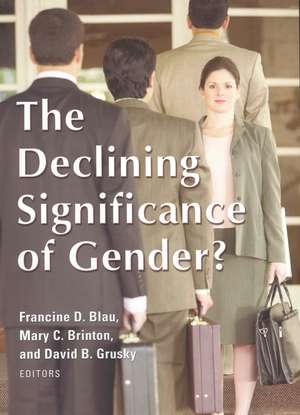The Declining Significance of Gender?
Editat de Francine D. Blau, Mary C Brinton, David B. Gruskyen Limba Engleză Paperback – 4 noi 2008
The last half-century has witnessed substantial change in the opportunities and rewards available to men and women in the workplace. While the gender pay gap narrowed and female labor force participation rose dramatically in recent decades, some dimensions of gender inequality—most notably the division of labor in the family—have been more resistant to change, or have changed more slowly in recent years than in the past. These trends suggest that one of two possible futures could lie ahead: an optimistic scenario in which gender inequalities continue to erode, or a pessimistic scenario where contemporary institutional arrangements persevere and the gender revolution stalls. In The Declining Significance of Gender?, editors Francine Blau, Mary Brinton, and David Grusky bring together top gender scholars in sociology and economics to make sense of the recent changes in gender inequality, and to judge whether the optimistic or pessimistic view better depicts the prospects and bottlenecks that lie ahead. It examines the economic, organizational, political, and cultural forces that have changed the status of women and men in the labor market. The contributors examine the economic assumption that discrimination in hiring is economically inefficient and will be weeded out eventually by market competition. They explore the effect that family-family organizational policies have had in drawing women into the workplace and giving them even footing in the organizational hierarchy. Several chapters ask whether political interventions might reduce or increase gender inequality, and others discuss whether a social ethos favoring egalitarianism is working to overcome generations of discriminatory treatment against women. Although there is much rhetoric about the future of gender inequality, The Declining Significance of Gender? provides a sustained attempt to consider analytically the forces that are shaping the gender revolution. Its wide-ranging analysis of contemporary gender disparities will stimulate readers to think more deeply and in new ways about the extent to which gender remains a major fault line of inequality.
Preț: 280.05 lei
Nou
Puncte Express: 420
Preț estimativ în valută:
53.59€ • 55.95$ • 44.25£
53.59€ • 55.95$ • 44.25£
Carte indisponibilă temporar
Doresc să fiu notificat când acest titlu va fi disponibil:
Se trimite...
Preluare comenzi: 021 569.72.76
Specificații
ISBN-13: 9780871543707
ISBN-10: 0871543702
Pagini: 306
Dimensiuni: 168 x 235 x 23 mm
Greutate: 0.52 kg
Editura: Russell Sage Foundation
Colecția Russell Sage Foundation
ISBN-10: 0871543702
Pagini: 306
Dimensiuni: 168 x 235 x 23 mm
Greutate: 0.52 kg
Editura: Russell Sage Foundation
Colecția Russell Sage Foundation
Notă biografică
FRANCINE D. BLAU is Frances Perkins Professor of Industrial and Labor Relations and Labor Economics at Cornell University. MARY C. BRINTON is Reischauer Institute Professor of Sociology at Harvard University. DAVID B. GRUSKY is professor of sociology at Stanford University. CONTRIBUTORS: Francine D. Blau, Mary C. Brinton, Paula England, Claudia Goldin, David B. Grusky, Heidi Hartmann, Robert Max Jackson, Lawrence M. Kahn, Vicky Lovell, Eva M. Meyersson Milgrom, Trond Petersen, Solomon W. Polachek, Cecilia L. Ridgeway, and Stephen J. Rose.
Cuprins
PART INTRODUCTION i Ci,pter 1 THE DECLINING SIGNIFICANCE OF GENDER? "Francine D. Blau, Mary C Brinton, and David B. Grusk 3 PART I MAKING SENSE OF CHANGE AND STABILITY IN GENDER INEQUALITY 35 C ipt'r 2 THE GENDER PAY GAP: GOING, GOING ... BUT NOT GONE FrancineD. Blau and La rence Mi ahn 37 Claptr 3 THE RISING (AND THEN DECLINING) SIGNIFICANCE OF GENDER Claudia Goldin 67 Chaptcr 4 HOW THE LIFE-CYCLE HUMAN-CAPITAL MODEL EXPLAINS WHY THE GENDER WAGE GAP NARROWED Solomon W. Polachek 102 CaMpte r HOW MUCH PROGRESS IN CLOSING THE LONG-TERM EARNINGS GAP? Heidi Hartmann, Stephen J. Rose, and Vicky L ovel 125 Chpter 6 THE GLASS CEILING IN THE UNITED STATES AND SWEDEN: LESSONS FROM THE FAMILY-FRIENDLY CORNER OF THE WORLD, 1970 TO 1990 Eva M. Meyersson Milgrom and rond Peersen 156 PART II POSSIBLE FUTURES OF GENDER INEQUALITY 213 Phptr 7p OPPOSING FORCES HOW, WH, AND WHEN WILL GENDER INEQUALITY DISAPPEAR? Robert Max Jackson 215 Chapter TOWARD GENDER EQUALITY PROGRESS AND BOTTLENECKS Paula England 245 Chapter 9 GENDER AS AN ORGANIZING FORCE IN SOCIAL RELATIONS: IMPLCATIONS FOR THE FUTURE OF INEQUALITY Cecilia L. Ridgeway 265
